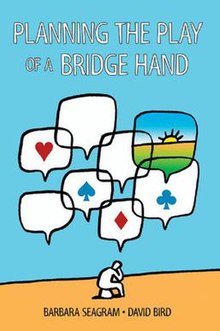
Contract bridge, or simply bridge, is a trick-taking card game using a standard 52-card deck. In its basic format, it is played by four players in two competing partnerships, with partners sitting opposite each other around a table. Millions of people play bridge worldwide in clubs, tournaments, online and with friends at home, making it one of the world's most popular card games, particularly among seniors. The World Bridge Federation (WBF) is the governing body for international competitive bridge, with numerous other bodies governing bridge at the regional level.
In the card game contract bridge, the Losing-Trick Count (LTC) is a method of hand evaluation that is generally only considered suitable to be used in situations where a trump suit has been established and when shape and fit are more significant than high card points (HCP) in determining the optimum level of the contract. The method is generally not considered suitable for no trump or misfit hands; also, the trump suit is generally considered to require at least eight cards in length with no partner holding fewer than three.
A squeeze play is a technique used in contract bridge and other trick-taking games in which the play of a card forces an opponent to discard a winner or the guard of a potential winner. The situation typically occurs in the end game, with only a few cards remaining. Although numerous types of squeezes have been analyzed and catalogued in contract bridge, they were first discovered and described in whist.
In the card game of contract bridge, to hold up means to play low to a trick led by the opponents, losing it intentionally in order to sever their communication. The primary purpose is to give as many tricks to opponents as needed to exhaust all the cards in the suit from one of their hands. If that hand regains the lead, it will not be able to put the partner on lead to cash its tricks. Hold up is one of basic techniques in play.
In trick-taking games, to ruff means to play a trump card to a trick. According to the rules of most games, a player must have no cards left in the suit led in order to ruff. Since the other players are constrained to follow suit if they can, even a low trump can win a trick. In some games, like Pinochle and Preferans, the player who cannot follow suit is required to ruff. In others, like Bridge and Whist, he may instead discard. Normally, ruffing will win a trick. But it is also possible that a subsequent player will overruff. This is not always a bad thing—see uppercut below.
Singaporean bridge is a re-invention of the traditional game of contract bridge deriving its name from where it is believed to have been invented, Singapore. There are many variations to the game which is primarily social, has no official book of rules and no formal organizing authority.
Minibridge is a simplified form of the complex card game Contract Bridge designed to expose newcomers to declarer and defensive playing techniques without the burden of learning a detailed bridge bidding system. The game was first introduced in France and the Netherlands in the 1990s. The variant described in this article is the one advertised by the English Bridge Union for use in primary schools as a way to improve pupils' performance in mathematics.
Ron Klinger is an Australian contract bridge player and a leading English-language bridge writer, the author of more than 70 books on the game. He is an Australian Grand Master and a World Bridge Federation International Master.
In the card game contract bridge, a suit combination is a specific subset of the cards of one suit held respectively in declarer's and dummy's hands at the onset of play. While the ranks of the remaining cards held by the defenders can be deduced precisely, their location is unknown. Optimum suit combination play allows for all possible lies of the cards held by the defenders.
Edwin Bruce Kantar was an American bridge player, winner of two open world championships for national teams, and prolific writer of bridge books and columns. Kantar was from Santa Monica, California.
Marty A. Bergen is an American bridge teacher, writer and player. A ten-time national champion and American Contract Bridge League Grand Life Master, he retired from active competition in 1993. He is still a bridge teacher and writer and is a World Bridge Federation World International Master. He was recently voted to be the 22nd most influential person in the history of bridge.

Larry Neil Cohen is an American bridge player, writer and teacher. He is best known as an advocate for the "Law of Total Tricks" as a guide in the bidding. He has won 25 North American Bridge Championships (NABC) events including the Vanderbilt, two Spingolds, two Reisingers, three Life Master Pairs, and four Blue Ribbon Pairs, and he is a two-time winner of the Cavendish Invitational Pairs cash prize tournament.
In contract bridge, card reading is the process of inferring which remaining cards are held by each opponent. The reading is based on information gained in the bidding and the play to previous tricks. The technique is used by the declarer and defenders primarily to determine the probable suit distribution and honor card holdings of each unseen hand; determination of the location of specific spot-cards may be critical as well. Card reading is based on the fact that there are thirteen cards in each of four suits and thirteen cards in each of four hands.
Master Point Press is a Canadian book publishing company located in Toronto, Ontario, Canada. It grew out of Canadian Master Point magazine (1992–1997), which was published by Ray and Linda Lee. The company began publishing books in 1994. While primarily interested in books on contract bridge, MPP also publishes books on other games and intellectual pursuits, such as chess.
Marc Smith is a British bridge player, columnist and writer. Marc Smith represented Great Britain as a junior, winning the 1985 European Union Junior Teams Championship. He has a host of wins in national events, and reached the final of the World Mixed Pairs Championship playing with his wife, Charlotte. His book, co-authored with Barbara Seagram, 25 Bridge Conventions You Should Know, won the American Bridge Teachers' Association 1999 Shirley Silverman Award for Best Student Book.

Barbara Seagram is a Canadian Registered Nurse and contract bridge writer, teacher, and administrator. She is co-author of thirty-two published bridge books, including co-writing with Marc Smith 25 Bridge Conventions You Should Know, which received the American Bridge Teachers' Association (ABTA) Book of the Year award in 1999. The book is in its 19th printing and has been translated into French, German, Japanese, Portuguese and Danish.

25 Bridge Conventions You Should Know is a book on contract bridge co-written by Canadian teacher and author Barbara Seagram and British player and author Marc Smith. It was published by Master Point Press in 1999.
Tim Bourke is an Australian bridge player and writer. He is internationally renowned as a collector and composer of bridge hands, or deals, having composed most of those in David Bird's "Abbot" series since 1996.
Patty Tucker is an American bridge player and teacher. In the world of competitive bridge, Tucker holds the honor and rank, American Contract Bridge League (ACBL) Grand Life Master. She also teaches duplicate bridge and is an author of 40+ bridge books and workbooks. The ACBL's Board of Directors named Patty the ”2016 Honorary Member of the Year" for her efforts in sustaining the game of bridge for future generations. Patty reflected, “I teach bridge for the immense satisfaction I get, in passing on to others, my knowledge, respect, and love for the game of bridge.”




